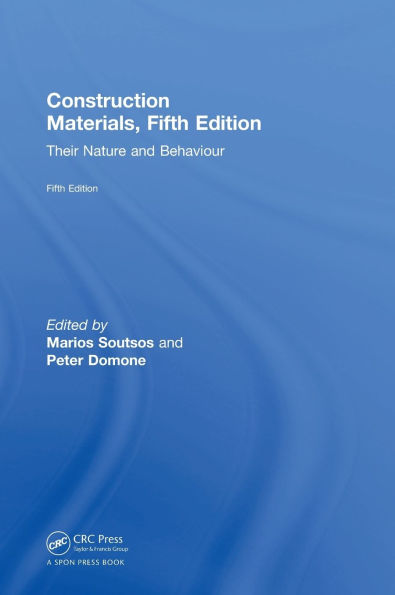Table of Contents
Part I: Fundamentals Revised and updated by Peter Domone and Marios Soutsos, with acknowledgment to the previous authors Bill Biggs, Ian McColl and Bob Moon
Chapter 1: Atoms, Bonding, Energy and Equilibrium
Chapter 2: Mechanical Properties of Solids
Chapter 3: Structure of Solids
Chapter 4: Fracture and Toughness
Chapter 5: Liquids, Viscoelasticity and Gels
Chapter 7: Electrical and Thermal Properties
Example Questions
Further Reading
Part II: Metals and Alloys
Revised and updated Marios Soutsos and Peter Domone, with acknowledgment to the previous authors Bill Biggs, Ian McColl and Bob Moon
Chapter 8: Deformation and Strengthening of Metals
Chapter 9: Forming of Metals
Chapter 10: Oxidation and Corrosion
Chapter 11: Iron and Steel
Chapter 12: Aluminium
Example Questions
Further Reading
Part III: Concrete
Marios Soutsos and Peter Domone
Chapter 13: Portland Cements
Chapter 14: Admixtures
Chapter 15: Additions
Chapter 16: Other Types of Cement
Chapter 17: Aggregates for Concrete
Chapter 18: Properties of Fresh Concrete
Chapter 19: Early Age Properties of Concrete
Chapter 20: Deformation of Concrete
Chapter 21: Strength and Failure of Concrete
Chapter 22: Concrete Mix Design
Chapter 23: Non-Destructive Testing of Hardened Concrete
Chapter 24: Durability of Concrete
Chapter 25: Special Concretes
Chapter 26: Recycling of Concrete
Example Questions
Further Reading
Part IV: Polymers
Revised and updated by Vasileios Koutsos with acknowledgement to the previous author Len Holloway
Chapter 27: Polymer Types, Properties and Applications
Further Reading
Part V: Fibre Composites FRP and FRC
Philip Purnell
Chapter 28: Reinforcing Fibre Materials
Chapter 29: Reinforcing Fibre Architecture
Chapter 30: Matrices
Chapter 31: Interfaces and Bonding
Chapter 32: Mechanical Behaviour and Properties of Composites
Chapter 33: Manufacture of Fibre Composites
Chapter 34: Applications of Fibre Composites in Construction.
Chapter 35: Durability
Chapter 36: Recycling
Further Reading
Part VI: Glass
Graham Dodd
Chapter 37: Manufacture and Processing
Chapter 38: Properties and Performance
Chapter 39: Design and Applications
Chapter 40: Service and End of Life
Further Reading
Part VII: Timber
John Dinwoodie
Chapter 41: Structure of Timber and the Presence of Moisture
Chapter 42: Deformation in Timber
Chapter 43: Strength and Failure in Timber
Chapter 44: Durability of Timber
Chapter 45: Processing and Recycling of Timber
Example Questions
Acknowledgment, Further Reading and Sources of Information
Part VIII: Masonry
Revised and updated by Paulo B. Lourenço with acknowledgment to the previous author Bob de Vekey
Chapter 46: Materials and Components for Masonry
Chapter 47: Masonry Construction and Forms
Chapter 48: Structural Behaviour and Movement of Masonry
Chapter 49: Non-Structural Physical Properties of Masonry
Chapter 50: Deterioration, Conservation and Strengthening of Masonry
Example Questions
Further Reading and Sources of Information
Part IX: Bituminous Materials
Gordon D. Airey
Chapter 51: Components of Bituminous Materials
Chapter 52: Viscosity, Stiffness and Deformation of Bituminous Materials
Chapter 53: Strength and Failure of Bituminous Materials
Chapter 54: Durability of Bituminous Mixtures
Chapter 55: Design and Production of Bituminous Materials
Chapter 56: Recycling of Bituminous Materials
Example Questions
Further Reading
Part X: Selection and Sustainable Use of Materials
Marios Soutsos and Peter Domone
Chapter 57: Mechanical Properties of Materials
Chapter 58: Sustainability and Construction Materials






